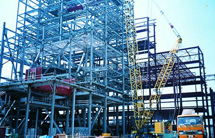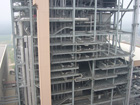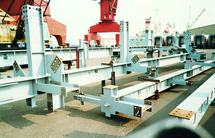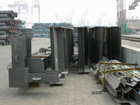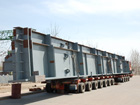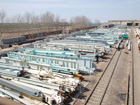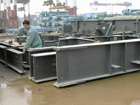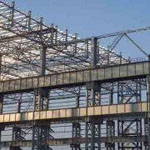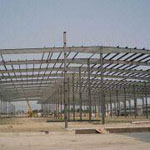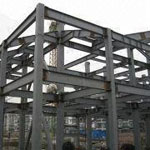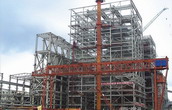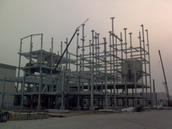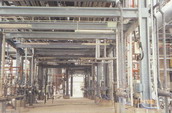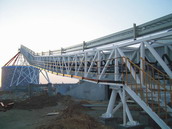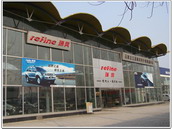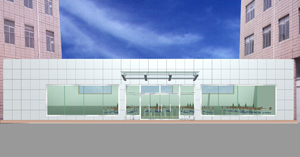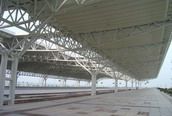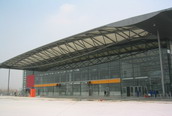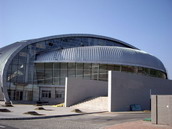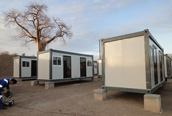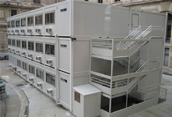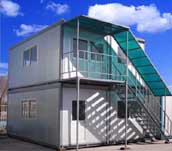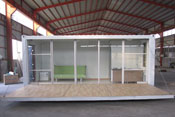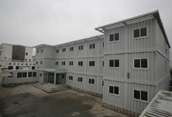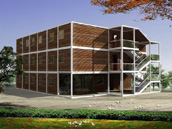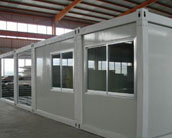Update on the steelstructureschina.com
Structural steel is steel construction material, a profile, formed with a specific shape or cross section and certain standards of chemical composition and mechanical properties. Structural steel shape, size, composition, strength, storage, etc., is regulated in most industrialized countries.
Structural steel members, such as I-beams, have high second moments of area, which allow them to be very stiff in respect to their cross-sectional area.
Contents
1 Common structural shapes
2 Standards
2.1 Standard structural steels (Europe)
2.2 Standard structural steels (USA)
2.2.1 Carbon steels
2.2.2 High strength low alloy steels
2.2.3 Corrosion resistant high strength low alloy steels
2.2.4 Quenched and tempered alloy steels
2.3 CE Marking
3 Steel vs. concrete
4 Thermal properties
5 Fire resistance
6 Manufacturing
7 See also
8 References
9 External links
Common structural shapes
In most developed countries, the shapes available are set out in published standards, although a number of specialist and proprietary cross sections are also available.
A steel I-beam, in this case used to support wood joists in a house.I-beam (I-shaped cross-section - in Britain these include Universal Beams (UB) and Universal Columns (UC); in Europe it includes the IPE, HE, HL, HD and other sections; in the US it includes Wide Flange (WF) and H sections)
Z-Shape (half a flange in opposite directions)
HSS-Shape (Hollow structural section also known as SHS (structural hollow section) and including square, rectangular, circular (pipe) and elliptical cross sections)
Angle (L-shaped cross-section)
Channel ( [-shaped cross-section)
Tee (T-shaped cross-section)
Rail profile (asymmetrical I-beam)
Railway rail
Vignoles rail
Flanged T rail
Grooved rail
Bar, a piece of metal, rectangular cross sectioned (flat) and long, but not so wide so as to be called a sheet.
Rod, a round or square and long piece of metal or wood, see also rebar and dowel.
Plate, metal sheets thicker than 6 mm or 1⁄4 in.
Open web steel joist
While many sections are made by hot or cold rolling, others are made by welding together flat or bent plates (for example, the largest circular hollow sections are made from flat plate bent into a circle and seam-welded).
Standards
Standard structural steels (Europe)
Most steels used throughout Europe are specified to comply with the European standard EN 10025. However, many national standards also remain in force.[citation needed]
Typical grades are described as 'S275J2' or 'S355K2W'. In these examples, 'S' denotes structural rather than engineering steel; 275 or 355 denotes the yield strength in newtons per square millimetre or the equivalent megapascals; J2 or K2 denotes the materials toughness by reference to Charpy impact test values; and the 'W' denotes weathering steel. Further letters can be used to designate fine grain steel ('N' or 'NL'); quenched and tempered steel ('Q' or 'QL'); and thermomechanically rolled steel ('M' or 'ML').
The normal yield strength grades available are 195, 235, 275, 355, 420, and 460, although some grades are more commonly used than others e.g. in the UK, almost all structural steel is grades S275 and S355. Higher grades are available in quenched and tempered material (500, 550, 620, 690, 890 and 960 - although grades above 690 receive little if any use in construction at present).
A set of euronorms define the shape of a set of standard structural profiles:
European I-beam: IPE - Euronorm 19-57
European I-beam: IPN - DIN 1025-1
European flange beams: HE - Euronorm 53-62
European channels: UPN - DIN 10261-1
Standard structural steels (USA)
Steels used for building construction in the US use standard alloys identified and specified by ASTM International. These steels have an alloy identification beginning with A and then two, three, or four numbers. The four-number AISI steel grades commonly used for mechanical engineering, machines, and vehicles are a completely different specification series.
The standard commonly used structural steels are:[1]
Carbon steels
A36 - structural shapes and plate
A53 - structural pipe and tubing
A500 - structural pipe and tubing
A501 - structural pipe and tubing
A529 - structural shapes and plate
High strength low alloy steels
A441 - structural shapes and plates
A572 - structural shapes and plates
A618 - structural pipe and tubing
A992 - W shapes beams only
A270 - structural shapes and plates
Corrosion resistant high strength low alloy steels
A242 - structural shapes and plates
A588 - structural shapes and plates
Quenched and tempered alloy steels
A514 - structural shapes and plates
A517 - boilers and pressure vessels
CE Marking
The concept of CE Marking for all construction products and steel products is introduced by the Construction Products Directive (CPD). The CPD is a European Directive that ensures the free movement of all construction products within the European Union.
Because steel components are “safety critical”, CE Marking is not allowed unless the Factory Production Control (FPC) system under which they are produced has been assessed by a suitable certification body that has been approved to the European Commission.[2]
In the case of steel products such as sections, bolts and fabricated steelwork the CE Marking demonstrates that the product complies with the relevant harmonized standard.[3]
For steel structures the main harmonized standards are:
Steel sections and plate - EN 10025-1
Hollow sections - EN 10219-1 and EN 10210-1
Pre-loadable bolts - EN 14399-1
Non-preloadable bolts - EN 15048-1
Fabricated steel - EN EN 1090 -1
The standard that covers CE Marking of structural steelwork is EN 1090-1. The standard has come in to force in late 2010. After a transition period of two years, CE Marking will become mandatory in most European Countries sometime early in 2014.[4] The official end date of the transition period is July 1st 2014.
Steel vs. concrete
As raw material prices fluctuate, often so does building design. During times of lower steel prices, more steel and less concrete is used, and vice versa. Each set of vendors and users typically maintain national industry associations that advocate the use of its materials versus the other. However, both materials are typically used together. Concrete without steel reinforcement (usually ribbed round bars called rebar) crumbles under tensile loads. Steel on its own, without composite or reinforced concrete floors, is likewise not a preferred building method.
While rebar is almost always steel, it is not considered a structural steel and is described separately in the reinforcement bar and reinforced concrete articles.
While both steel structures and reinforced concrete cement (R.C.C) structures have their pros and cons, the steel structures have better strength-to-weight ratios than RCC and can be easily dismantled. Steel structures, which have bolted connections, can also be reused to some extent after dismantling.
Thermal properties
The properties of steel vary widely, depending on its alloying elements.
The austenizing temperature, the temperature where a steel transforms to an austenite crystal structure, for steel starts at 900°C for pure iron, then, as more carbon is added, the temperature falls to a minimum 724°C for eutectic steel (steel with only .83% by weight of carbon in it). As 2.1% carbon (by mass) is approached, the austenizing temperature climbs back up, to 1130°C. Similarly, the melting point of steel changes based on the alloy.
The lowest temperature at which a plain carbon steel can begin to melt, its solidus, is 1130 °C. Steel never turns into a liquid below this temperature. Pure Iron ('Steel' with 0% Carbon) starts to melt at 1492 °C (2720 °F), and is completely liquid upon reaching 1539 °C (2802 °F). Steel with 2.1% Carbon by weight begins melting at 1130 °C (2066 °F), and is completely molten upon reaching 1315 °C (2400 °F). 'Steel' with more than 2.1% Carbon is no longer Steel, but is known as Cast iron.[5]
Fire resistance
Metal deck and open web steel joist receiving spray fireproofing plaster, made of polystyrene leavened gypsum.Steel loses strength when heated sufficiently. The critical temperature of a steel member is the temperature at which it cannot safely support its load. Building codes and structural engineering standard practice defines different critical temperatures depending on the structural element type, configuration, orientation, and loading characteristics. The critical temperature is often considered the temperature at which its yield stress has been reduced to 60% of the room temperature yield stress.[6] In order to determine the fire resistance rating of a steel member, accepted calculations practice can be used,[7] or a fire test can be performed, the critical temperature of which is set by the standard accepted to the Authority Having Jurisdiction, such as a building code. In Japan, this is below 400°C[citation needed]. In China, Europe and North America (e.g., ASTM E-119), this is approximately 1000–1300F[8] (530-810C). The time it takes for the steel element that is being tested to reach the temperature set by the test standard determines the duration of the fire-resistance rating. Heat transfer to the steel can be slowed by the use of fireproofing materials, thus limiting steel temperature. Common fireproofing methods for structural steel include intumescent, endothermic and plaster coatings as well as drywall, calcium silicate cladding, and mineral or high temperature insulation mineral wool blanket.
Concrete building structures often meet code required fire-resistance ratings, as the concrete thickness over the steel rebar provides sufficient fire resistance. However, concrete can be subject to spalling, particularly if it has an elevated moisture content. Although additional fireproofing is not often applied to concrete building structures, it is sometimes used in traffic tunnels and locations where a hydrocarbon fuel fire is more likely, as flammable liquid fires provides more heat to the structural element as compared to a fire involving ordinary combustibles during the same fire period. Structural steel fireproofing materials include intumescent, endothermic and plaster coatings as well as drywall, calcium silicate cladding, and mineral or high temperature insulation wool blankets. Attention is given to connections, as the thermal expansion of structural elements can compromise fire-resistance rated assemblies.
Manufacturing
Cutting workpieces to length is usually done with a bandsaw.
A beam drill line (drill line) has long been considered an indispensable way to drill holes and mill slots into beams, channels and HSS elements. CNC beam drill lines are typically equipped with feed conveyors and position sensors to move the element into position for drilling, plus probing capability to determine the precise location where the hole or slot is to be cut.
For cutting irregular openings or non-uniform ends on dimensional (non-plate) elements, a cutting torch is typically used. Oxy-fuel torches are the most common technology and range from simple hand-held torches to automated CNC coping machines that move the torch head around the structural element in accordance with cutting instructions programmed into the machine.
Fabricating flat plate is performed on a plate processing center where the plate is laid flat on a stationary 'table' and different cutting heads traverse the plate from a gantry-style arm or "bridge." The cutting heads can include a punch, drill or torch.
See also
Diamond plate
Dowel
Flame cleaning
Open web steel joist
Railway rail
Structural engineering
Structural shape rolling
References
^ Manual of Steel Construction, 8th Edition, 2nd revised printing, American Institute of Steel Construction, 1987, ch 1 page 1-5
^ The website of the British Constructional Steelwork Association Ltd. - SteelConstruction.org:CE-Marking.08/02/2011.
^ Guide to the CE Marking of Structural Steelwork, BCSA Publication No. 46/08. p.1.
^ Manufacturer Certification in Compliance with EN 1090, 09.08.2011
^ http://www.msm.cam.ac.uk/phase-trans/images/FeC.gif
^ Industrial fire protection engineering, Robert G. Zalosh, copyright 2003 pg.58
^ Zalosh, Pg. 70
^ Zalosh, Table 3.3
External links
Wikiquote has a collection of quotations related to: Structural steel
Wikimedia Commons has media related to: Structural Steel
The American Institute of Steel Construction, Inc.
Product Data Standards for Structural Steel (CIS/2, IFC) The product data standards facilitate interoperability between CAD software. SteelVis is visualization software for CIS/2 files.
International Association of Bridge, Structural, Ornamental, and Reinforcing Iron Workers
The construction products directive (CPD)
SteelConstruction.org - CE Marking
Guide to the CE Marking of Structural Steelwork, BCSA Publication No. 46/08.
Manufacturer Certification in Compliance with EN 1090
Retrieved from "http://en.wikipedia.org/w/index.php?title=Structural_steel&oldid=480281657"
Categories: Structural engineeringSteels
categories: Articles needing cleanup from January 2008All articles needing cleanupCleanup tagged articles without a reason fieldArticles needing additional references from July 2009All articles needing additional referencesAll articles with unsourced statementsArticles with unsourced statements from August 2011Articles with unsourced statements from July 2011


